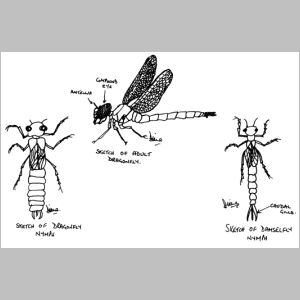Bulletin 12 - November 1980: Dragonflies and Damselflies
Dragonflies and Damselflies
by Diane DonohueOrder Odanata
Anisontera: DragonfliesZygontera: Damselflies
Dragonflies
The dragonfly is a member of the order Odanata (meaning toothed). As there is no pupal stage, development of Odanata is known as incomplete metamorphosis.
Odanata have existed since the Carboniferous Age, about 300 million years ago and at that time species of enormous size existed such as Meganeura, which had a wingspan of 65 cm (over 25 inches).
Dragonflies are recognized by their elongated bodies (although there are species with short bodies), protuberant eyes and two pairs of well-developed wings.
The eyes are the main organs of sense as the antennae, normally the main area of the senses of touch and smell, are poorly developed. The eyes of true dragonflies usually meet, or almost meet, at the top of the head. They are mainly day-flying insects and rely entirely on their sight. They can perceive shapes up to 5 - 6 m (16 - 19 feet) away and movement up to 15 - 20 m (50 - 60 feet).
Dragonflies are generally bright colored and species may be recognized by color alone. However, females differ in color or pattern from males; the insects change color as they mature and young specimens are generally paler than older ones so that color alone should not be taken as positive identification. The colors do fade after death unless specific techniques in preservation are followed; even then, the color may change so identification must be made while the specimen is still alive and certainly before treating and setting.
Dragonflies are rarely motionless for more than a few seconds at a time with a flight that is quick and varied. They hover motionless in the air or climb, dive and swerve to right or left, backward and forward. They can cover distances of hundreds of kilometers but are only highly active in warm temperatures and sunlight.
Dragonflies are predacious and are always on the hunt for food, preying on a varied diet of insects, devouring the prey by crushing it to a pulp or chopping it to pieces with their well-developed mouthparts, the mandibles being strongly toothed. Because their diet consists mainly of other insects such as mosquitoes, flies, etc., they are considered beneficial insects, being an invaluable help to man in the biological control of pests.
The female lays here eggs on the water's edge or actually in the water either singly or in batches on leaves of plants or stems of rushes using the ovipositor. More discerning females will carefully conceal their eggs within submerged plants immersing themselves completely in the water in order to lay the eggs. The male often helps during the egg laying time by retaining a tight hold of the female and assisting her back into flight when the eggs have been laid. If the ovipositor of a species is poorly developed, then the eggs are laid directly in the mud or rather haphazardly directly onto the water.
The larva, though small, is equipped with legs, eggs and extremely strong jaws. It also is predacious and feeds on crustaceans, worms, tadpoles etc. When first hatched, it feeds on microorganisms. To capture the prey, the larva uses its labium or lower lip, which is known as a 'mask'. This is elongated and hinged in the middle with pincers at the end. When not in use, it folds back under the head concealing the face. The larva breathes by means of tracheal gills concealed within the rectum.
The life cycle of dragonflies takes from one to five years, perhaps longer; the nymph life span relies on availability of food and the prevailing temperatures. When the nymph is fully grown, it stops feeding, climbs onto a plant until it is either partly or entirely out of the water and, within a few hours, it transforms into an adult. During its life, the nymph will molt several times.
Damselflies
Damselflies are slender, delicate and less robust than dragonflies.
At rest, the wings of the damsel are held vertically over the body or partly spread, whereas true dragonflies rest with the wings outspread. The larva of damselflies breathes through caudal gills, tail-like appendages at the end of the abdomen.
Contrary to popular belief, dragonflies are quite incapable of stinging because they do not possess a sting of any kind. Even though their jaws are well developed, they are not sufficiently strong to penetrate the skin and can be handled without any fear of them biting.
